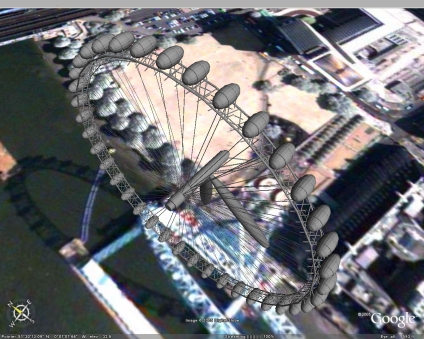Digitally Distributed Environments posts another awesome model of a London landmark for Google Earth: The London Eye.

Digitally Distributed Environments posts another awesome model of a London landmark for Google Earth: The London Eye.

Another tranche of imagery has been made available of the Earthquake zone in Pakistan. Kathryn Cramer has the details.
Cool! Tagzania has just granted my very own feature request — a link to Google Earth for individual placemarks.
This means that, for example, a place that I’ve marked on a Google Map via Tagzania is now accessible via Google Maps, Google Earth, MSN Virual Earth, Multimap, Mapquest and as a search in GeoURL. (And you can even paste the placemark, map and all, into any website you like.)
Previously, Tagzania places were only viewable in Google Earth as part of a user’s complete set of items for a particular tag or user. Now there is granular control, which makes Tagzania very much the del.icio.us of places. I just keep my places there, tag them, and let the user decide how to view them.
After some initial confusion as to what exactly it was that MapInfo had decided to do with Google Earth, the matter has been cleared up with a search for “KML” on MapInfo’s site, which yielded these results:
A Product guide for the MapInfo Link Utility for Google Earth.
Release notes for the Link Utility.
Basically, it lets you export existing MapInfo maps as KML/KMZ for viewing in Google Earth. No biggie, really. It’s sort of expected that self-respecting GIS companies do KML these days:-) (Moshe Binyamin from MapInfo comments on All Points Blog that the utility will probably be released on November 11.)
Australian Computerworld has an interesting article about Google’s plans for the business versions of Google Earth, Pro and Enterprise.
These two versions are being placed under the “guidance” of Google’s enterprise unit, and the article quotes one Google exec at length:
“There’s definitely a lot of potential for integration between the Google Earth products and the Search Appliance and the Google Mini. We’re starting to look at what might make sense,” said Dave Girouard, general manager of the Google Enterprise unit.
Considering that the Search appliance starts at $30,000 and mini at $3,000, ads are unlikely in future business versions of Google. There is still no sign that that these versions will be aimed at GIS pros, though — rather they seem to position Google Earth as a snazzier more versatile way of viewing geosearch results.
Google is looking for a Google Earth client software engineer for the Win32 platform. Intriguingly, “familiarity with QT is a plus.” Intriguing because that either refers to Apple’s QuickTime, or else Trolltech’s Qt, the crossplatform GUI application development toolkit for X11, Mac, Linux and Windows.
(Posted earlier today to Simply Hired)
If I may be so bold as to highlight a snippet of a comment left by Brian Flood on James Fee’s blog regarding those Google Earth ads:
This is AdSense not AdWords we’re talking about here. AdSense allows individuals to share in the profit. AdWords is primarily for the main Google Search page. So as a publisher of data, you could *choose* to place AdSense keywords in your KML and share in the click-through revenue with Google. […] This is something that could actually improve the quality of data, that is, shared ad revenue could help offset the cost of collecting/maintaining some datasets.
If this is turns out to be correct (and I suspect it is) it would make absolute sense (with hindsight), as the recurring metaphor for Google Earth is that it is a browser, with layers published to be rendered by Google Earth akin to websites published to be rendered by conventional browsers. And in both cases, it would be the content producers whom Google gives the option to show Google ads if they feel the need to be rewarded for their efforts.
In which case, the revenue model for Google Earth changes slightly. Sure, you can still pay upfront to remove all ads, but in other cases, Google shares its revenue with content producers, which spurs content for Google Earth, which in turn spurs its use. This is even more sophisticated than the Opera model.
And it has the potential to be quite devious too. Imagine a content producer who has enabled AdSense ads for his network link showing the 50 nearest casinos for a given view. Imagine ArcGIS Explorer being able to render KML (it will). Will ArcGIS Explorer then render the AdSense ads that come with the casino network layer, or will it choose to ignore them? Show them, and Google makes money while ESRI serves the base data and foots the bill. Skip them, and the content provider makes no money. Might ESRI rip out the AdSense ads and place generic ads elsewhere to pay its own bills for serving the base data? Would this be legal?